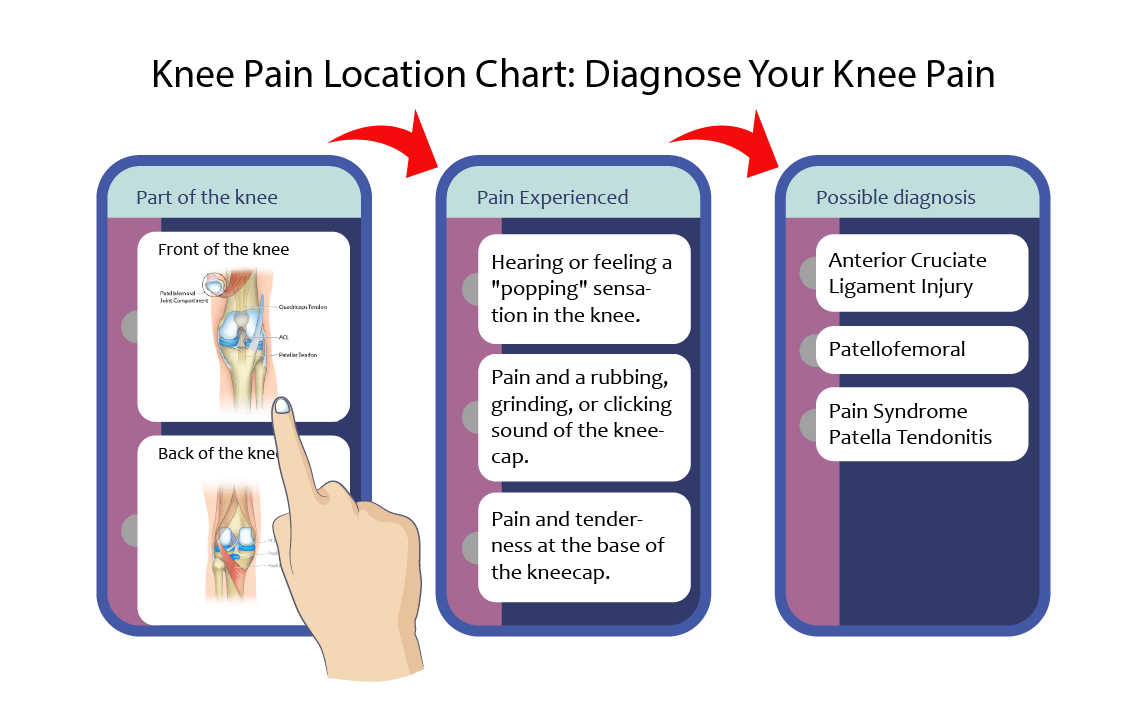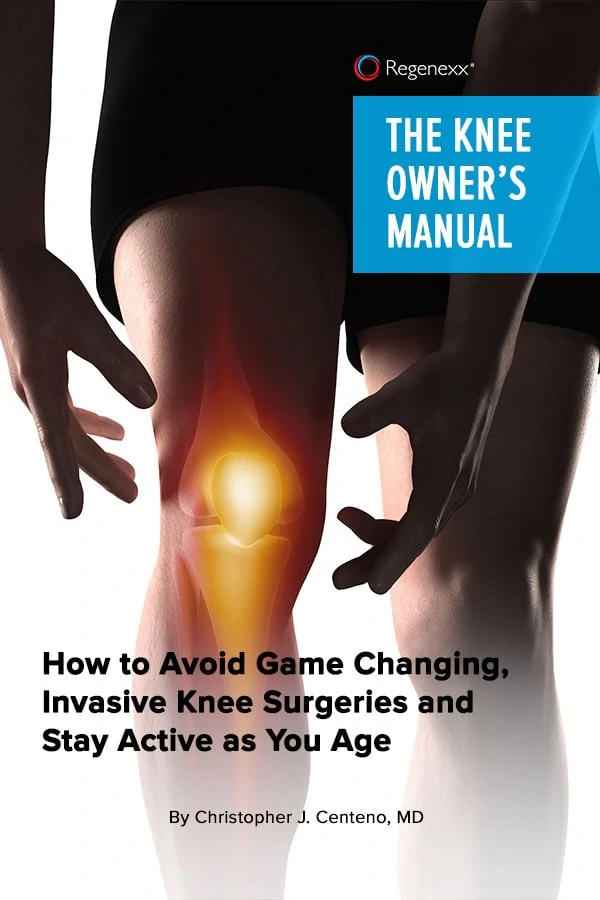The knee joint is the largest compound synovial joint of the human body. The joint has bones, cartilage, muscles, and bursae that are held together by ligaments and tendons. Damage to any of these structures can give rise to knee pain.
The location of knee pain can be very telling, and can help narrow down the diagnosis. That is why we have created a knee pain location chart. This will give you a brief idea of what is causing your knee pain.
Knee Anatomy

Bones In The Knee
The knee joint is made up of three bones: the tibia, femur, and patella.
Tendons In The Knee
The major tendons at the knee joint are the iliotibial band, quadriceps tendon, patella tendon, and hamstring tendons.
Muscles In The Knee
The muscles that move the knee can be divided into two main groups: flexors and extensors. The flexors bend the knee, and include the articularis genus, vastus lateralis, vastus intermedius, vastus medialis, and rectus femoris. They originate from the femur and anterior inferior iliac spine.
The extensors straighten the knee, and include the biceps femoris, semitendinosus, semimembranosus, gastrocnemius, plantaris, popliteus, and gracilis. They originate from the ischial tuberosity, inferior pubic ramus of the hip bone, and the femur. They attach to the tibia, fibula, and calcaneus.
Ligaments In The Knee
The major ligaments of the knee joint are the anterior cruciate ligament (ACL), posterior cruciate ligament (PCL), medial cruciate ligament (MCL), and lateral cruciate ligament (LCL).
Bursae In The Knee
Bursae are small fluid-filled sacs that cushion the knee joint. There are five major bursae in the knee joint: the prepatellar, suprapatellar, infrapatellar, pes anserine, and the semimembranosus bursa.
Blood Supply And Lymphatics In The Knee
The knee receives blood supply from arterial branches of the popliteal artery and femoral artery. The lymph from the knee and lower leg drains into the popliteal lymph nodes in the popliteal fossa. The popliteal nodes, along with lymphatics from the lower limb drain into the inguinal nodes.
Nerves In The Knee
The major structures in the knee and many of the flexor muscles receive their nerve supply from branches of the femoral nerve (L1, L2, L3). L1, L2 and L3 are lumbar nerve roots that are named based on the vertebra that lies above them. The extensor muscles receive their nerve supply from the sciatic nerve (L4, L5, S1, S2, S3).
Symptoms Of A Knee Injury
Different knee injuries can cause a range of different symptoms. Some common symptoms of an injury to the knee may include:
- Knee pain
- Swelling of the joint
- An inability to flex or extend the knee
- Popping or locking of the joint
- Numbness
- Tingling in the skin overlying the joint
- Fever
- Redness of the joint
- Joint stiffness
- Referred pain to the calf or buttock
Pain In Different Areas Of The Knee Could Mean Different Things
If you look at the knee pain location chart, you can see that the knee can be divided into different compartments. You have the inside (or the medial part) of the knee, the outside (or the lateral part)of the knee, the center of the knee, above and below the knee itself, and the back of the knee.
The location of your knee pain can indicate the diagnosis. For example, in the knee pain location chart, knee pain in the medial side of the knee joint could indicate injuries to the medial meniscus, medial collateral ligament, or pes anserine bursa.
Similarly, injury to the lateral collateral ligament and the iliotibial band can cause pain in the lateral side of the knee. There can also be some overlap when it comes to pain location. For example, osteoarthritis can cause pain
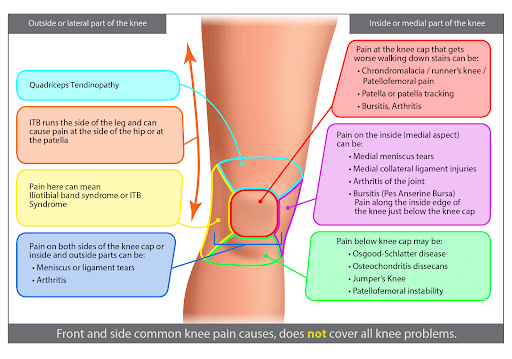
Pain In The Front Of And Above The Knee
The front of the knee and area above the knee are occupied by the quadriceps tendon, the patella, the synovium which lines the entire knee joint and lubricates the joint, and the plica covering the joint. Some of the possible diagnoses that can cause pain in the front of and above the knee are the following:
- Quadriceps Tendonitis: The quadriceps tendon is located slightly above the patella. The quadriceps tendon stretches from the top of the femur across the patella.
Quadriceps tendonitis is an inflammation of the quadriceps tendon due to sports like jumping, volleyball, and soccer. Because of the location of the quadriceps, the area in the front of the knee and above the knee can become tender or painful. - Patellofemoral Arthritis: Patellofemoral arthritis is the term for arthritis that develops on the underside of the patella and in the groove in the femur where the patella sits. Arthritis can cause pain in the front and the area above the patella.
- Plica Syndrome: Plica is a thick band of fibrotic tissue extending from the synovial capsule of a joint. Plica syndrome affects the knee most commonly and is caused by irritation due to friction over the patella or the medial femoral condyle.
In this syndrome, the formation of fibrotic folds in the medial knee are quite common and so the pain due to inflammation is usually experienced in the front and area above the patella. - Lateral Patellar Facet Overload Syndrome: Lateral patellar facet overload syndrome is commonly seen in skiers and cyclists.
When any form of trauma affects the lateral facet of the patella, if there is a partial dislocation or is attached to very tight, weak muscles, the lateral facet can get compressed and lead to pain in the front and area above the patella. - Synovitis: Synovitis of the knee can be caused by inflammation or irritation of the synovial membrane of the knee. It can also develop from other primary conditions like infection, cancer, and gout. Synovitis leads to pain in the front and above the patella as the synovial membrane stretches over the joint.
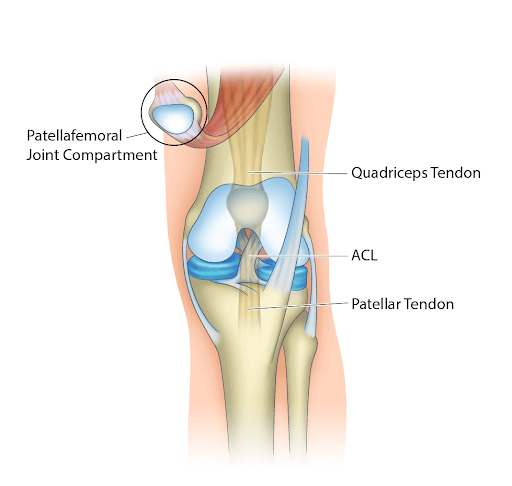
Pain In The Front Of And Inside The Knee
The front and inner knee contains the patellar tendon, the ACL, the quadriceps tendon, and the patellofemoral joint compartment. Injuries to these structures can lead to the following diagnoses.
Possible Diagnoses
Here are some possible diagnoses that cause pain in the front of and inside the knee:
- Anterior Cruciate Ligament Injury: The anterior cruciate ligament (ACL) is one of the major ligaments in the knee, and prevents unwanted forwards and backwards movement of the joint.
Anterior cruciate ligament injury can include a tear or rupture. ACL injuries commonly occur in high-demand sports like soccer and basketball where athletes stop suddenly, land incorrectly on a jump, change direction rapidly, or collide in a tackle. Pain from an ACL injury is usually felt inside the knee and at the front of the knee. - Patellofemoral Pain Syndrome: Patellofemoral pain syndrome, also called runner’s knee, is commonly seen in people who run or squat. When the patella is strained due to repetitive or high intensity activities like squatting or running, it can cause pain where the patella meets the femur.
Due to the central location of the patella, people affected by patellofemoral pain syndrome often experience pain in the front of the knee. - Patella Chondromalacia: Patella chondromalacia is a condition that occurs when the cartilage on the underside of the patella softens and breaks down. It can happen due to fracture, dislocation of the patella, or overuse.
As it involves the patella, patella chondromalacia can cause pain in the front of and inside the knee. - Patellofemoral Arthritis: Patellofemoral arthritis occurs due to the degeneration of the underside of the patella. This can occur due to cartilage damage from subluxations, trauma, overload, and osteoarthritis.
Patellofemoral arthritis can cause pain in the front and the inside of the knee due to the involvement of the patella and the femur. - Dislocated Patella: The patella sits in the groove of the femur and moves to allow the knee to bend and straighten. However, as a result, the patella is prone to dislocation. When the patella dislocates due to a collision, accident, or fall, it can lead to pain in the front and the inside of the knee.
Patella dislocations usually only occur in collision or high intensity sports. Previous injuries to the knee or hyperlaxity can also increase the risk of dislocation if it affects the patellar ligaments, making the patella more prone to dislocations. - Patella Tendonitis: The patellar tendon connects the patella to the tibia. Patellar tendonitis, also called Jumper’s knee, is caused by overuse and repeated stress on the tendon which causes tiny tears in the patellar tendon.
As the tears multiply, the tendon gets weaker due to inflammation. Tendonitis causes pain in the front and inside the knee. - Osgood-Schlatter Disease: Osgood-Schlatter disease is a pediatric disease commonly seen in adolescent athletes, where repeated traction of the tibial tubercle leads to microvascular tears and fractures.
The repeated force of the patellar tendon where it inserts at the soft tibial tubercle can cause tears in immature skeletal muscle. This can lead to pain in the front of and inside the knee due to the involvement of the patellar tendon. - Sinding-Larsen-Johansson Syndrome: This is another juvenile condition that affects the area where the patellar tendon attaches to the inferior pole of the patella. The pain commonly occurs in the front of the knee and worsens with exercise.
The traction on the patellar ligament inflames the insertion at the inferior pole of the patella. It occurs during the growth spurt in adolescence and can develop from trauma and overuse. - Bursitis: Inflammation of the bursa in the knee can cause pain in the front of and inside the knee. Constant kneeling, injuries, and scrapes leading to infections can contribute to inflammation, causing the bursae to produce more fluid. This makes the knee swell and puts more pressure on the knee joint.
- Osteoarthritis: Osteoarthritis is a degenerative joint disease where the cartilage slowly degrades over time, commonly from injury or aging. This reduces ease of movement in the joint, causing pain in and around the knee.
Additionally, the formation of osteophytes or bony spurs can make the joint stiff and worsen the symptoms of knee pain. - Bone Tumors: Pain at the front of and inside the knee is a common symptom of bone tumors, especially osteosarcoma. The knee is one of the common sites for this type of bone tumor to develop.
The tumor can grow and invade the surrounding tissue, which worsens the pain as a result. Bone tumor pain is often more pronounced at night. - Inflammatory Joint Disease: Inflammatory joint disease is a broad term for autoimmune conditions where the immune system is hyperactive. These conditions cause inflammatory molecules and cells to attack the joint, leading to pain in the knee.
Some of these conditions include gout, rheumatoid arthritis, psoriatic arthritis, pseudogout, idiopathic arthritis, and ankylosing spondylitis, among others. The constant inflammation can cause pain, swelling, and joint stiffness.
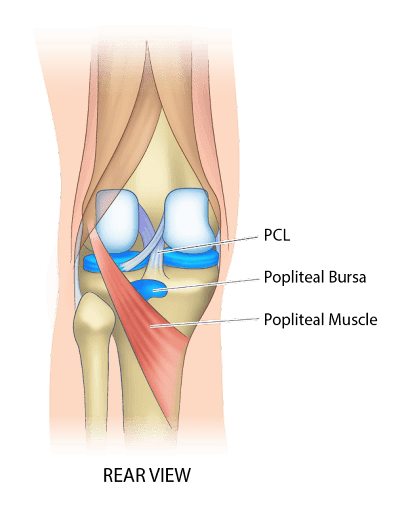
Pain At The Back Of The Knee
At the back (posterior part) of the knee, damage to the posterior cruciate ligament, the popliteus muscles, and the popliteal bursa can cause pain. Some of the possible diagnoses are the following.
Possible Diagnoses
Here are some possible diagnoses that cause pain in the back of the knee:
- Hamstring Tear Or Strain: The hamstring muscles are located at the back of the thigh and insert at the femur and tibia. When the hamstrings are stretched or torn due to poor muscle strength, or during lunging or jumping movements, a person can experience sharp, intense pain in the back of the knee since these muscles stretch across the tibiofemoral joint.
- Hamstring Tendonitis: When the tendons of the hamstring muscles are inflamed due to overuse or a sudden hamstring injury, pain can develop in the back of the thigh or back of the knee.
- Popliteus Muscle Injury: Injury to the popliteus muscle, which is a small muscle located behind the knee, can cause pain at the back of the knee. Accidents and falls with an overextended knee, tight hamstring muscles, and overuse as seen in runners can all cause popliteus muscle tears.
- Cramps: Cramps or muscle spasm of the gastrocnemius and popliteus muscles can cause pain in the posterior knee. Cramps can occur due to dehydration, electrolyte imbalances, or overuse of the muscles. This type of pain usually resolves over time.
- Posterior Cruciate Ligament Injury: The posterior cruciate ligament is one of the major ligaments in the knee, and prevents unwanted forwards and backwards movements in the joint. Given its location, any injury or tear to the posterior cruciate ligament can cause pain in the back of the knee.
PCL injury or tears usually only occur when an extreme amount of anterior force is applied to the proximal tibia when the knee is flexed. For example, falling forward on a flexed knee or vehicular accidents can cause this type of injury. PCL injuries are common in athletes that play sports like football, skiing, and baseball. - Baker’s Cyst: A Baker’s cyst, also called a popliteal cyst, is a cyst in the popliteal fossa at the back of the knee. As the cyst increases in size, it causes pain in the posterior knee and can reduce movement or range of motion. Baker’s cysts can occur due to tears of the cartilage, degenerative joint disease, and trauma.
- Meniscal Tears Or Loose Cartilage: A meniscus tear can cause pain in the back of the knee. This is due to the location of the menisci that occupy the center of the knee. In this condition, a piece of loose cartilage can float in the joint fluid and irritate the joint further which can further worsen the pain at the back of the knee.

Pain Inside The Knee
Inside the knee, the medial meniscus lies between the femur and the tibia. Damage or disease of any of these structures can lead to pain inside the knee. Some possible diagnoses are as follows.
- Irritation Of The Medial Plica: There are folds or plica that line the knee joint. When one of the folds, like the medial plica, becomes inflamed, pain can develop inside the joint. This can occur due to trauma to the knee and even bruising of the knee. Movements like bending may aggravate any symptoms or cause the knee to swell.
- Medial Meniscus Tear Or Loose Cartilage: The medial meniscus can tear, commonly due to twisting of the knee while the foot is firmly planted. This type of injury can lead to intense pain inside the knee.
Sometimes the meniscus can tear and a piece of it may chip off and float within the joint space, irritating the joint and causing it to swell. The joint may become tight or stiff, worsening any pain or symptoms, particularly when the knee is moved. - Osteoarthritis: Osteoarthritis in the joint and the formation of bony spurs on the femur and tibia can lead to pain inside the joint. The joint can also become very stiff due to erosion of the cartilage, making it difficult to move the knee or complete activities like walking or climbing stairs.
- Medial Collateral Ligament Damage: Any damage to the medial collateral ligament located on the medial side of the knee can cause pain inside the joint. This happens when the knee is hit from the outside. The ligaments can be completely stretched or torn, causing pain, stiffness, or even the sensation of “locking” in the knee.
- Osteochondral Defect: An osteochondral defect in a localized area of damage in the cartilage or underlying bone. It can be caused by a bone disorder or microtrauma, and the defects can gradually become necrosed as the blood supply is compromised. This can lead to pain and other symptoms inside the joint.
- Avascular Necrosis: Injured or dislocated bones can compromise the blood supply to part of the tibia or the femur. When blood supply is lost, the bone cells die as they do not receive oxygen and nutrition. When enough bone cells die, the necrosed or dead bone causes pain in the inside of the joint.

Pain Outside The Knee
Various muscles attach to the femur and the tibia. Pain in the outside of the knee can be caused by inflammation in any of these muscles, including the hamstrings and iliotibial band. Pain outside the knee can also be due to the structures in the lateral side of the knee, like injury to the lateral meniscus or the lateral collateral ligament, that refer the pain to the outside of the knee. Some possible diagnoses are as follows.
- Hamstring Tendonitis: Hamstring tendonitis presents as pain outside the knee that is referred from the buttock area. So, people often complain of buttock pain and knee pain on the outside. It is seen frequently in young runners and people who lunge often leading to chronic overuse of the hamstrings.
- Iliotibial Band Syndrome: Iliotibial band (ITB) syndrome is an overuse injury, where the iliotibial band becomes inflamed from repetitive movements like running or cycling. The pain is usually felt in the lateral knee where the ITB crosses and attaches to the knee joint
- Lateral Collateral Ligament Damage: A high-energy blow to the medial knee can cause damage to the lateral collateral ligament. This is usually seen in high-contact sports and athletes who do a lot of high-velocity jumping and pivoting, and gives rise to pain in the outside of the knee.
- Lateral Meniscus Tear: Lateral meniscus tears can develop suddenly from a traumatic injury or may develop gradually over time.
For example, they can develop as the cartilage frays over time or from a large rotational shearing force on the knee, such as a twisting motion or traumatic injury. The pain is usually experienced in the outside of the knee, especially along the joint line where the lateral meniscus is located. - Osteoarthritis: Osteoarthritis is a form of degenerative arthritis. The cartilage breaks down over time as changes in the bone occur, like the formation of bone spurs. As the cartilage degrades, it can lead to inflammation and outer knee pain.
- Meniscal Cysts: Meniscal cysts occur within the menisci. They occur due to meniscal tears and occur laterally, causing pain outside of the knee. The cyst itself contains the joint fluid, and can cause the entire joint to swell.
- Dislocation Of The Joint With Possible Nerve Damage: If the knee joint dislocates due to a severe fall or trauma, it’s common to experience pain in the outside of the knee. Knee dislocation is often accompanied by possible nerve damage. If the nerve is damaged, the pain may not be within the joint but outside the knee and in the thigh.
- Tibial Plateau Fracture: Tibial plateau fractures are a type of fracture in the proximal tibia. Since the tibia forms part of the knee joint, tibial plateau fractures are considered to be a periarticular knee fracture.
Tibial plateau fractures are classified into six types based on two-dimensional images using the Schatzker classification. This is important to guide surgical treatment, the path the surgeon will take either anteriorly or posteriorly and to determine where the hardware should be applied to achieve stable fixation. - Posterolateral Corner Injury: Posterolateral corner injury is a type of traumatic knee injury that causes pain in the outside knee and at the back of the knee. It is associated with lateral knee instability and can occur in conjunction with a posterior cruciate ligament injury.
Posterior corner injuries are classified into three grades based on the extent of damage to the lateral structures or the degree of posterolateral rotatory instability.
Risk Factors Of Knee Pain
Studies show that certain risk factors increase the chances of knee pain (1). The risk factors for knee pain include the following:
- Age: Age is a significant risk factor for knee pain, primarily because with age the wear and tear of the joint increases. In addition, the hydration of the cartilage and joint fluid decreases over time, making the movement between the bones exceedingly stiff. This can increase the risk of knee pain.
- Gender: Women have a higher predisposition to knee pain. After menopause, without the protective effect of estrogen on the bones, women are more likely to develop conditions like osteoporosis. Weaker bones are more easily damaged or prone to arthritis, which can cause knee pain.
- Genetics: There are some genetic links to osteoarthritis and knee pain. The presence of certain collagen genes is strongly linked with inflammatory conditions like osteoarthritis and rheumatoid arthritis, which can cause knee pain.
- Body Mass: Body mass can increase the risk of developing knee pain. The higher the body mass, the more pressure on the joints. This leads to greater stress and wear on the muscles, bones, and ligaments, which can lead to knee pain. A higher percentage of fat also affects the metabolism of the cartilage.
- Muscular Strength: Weaker muscles cannot support the joint as easily when large forces move through them. This may cause the joint to loosen and dislocate, especially when the muscles are inactive or atrophy due to lack of use. Knee pain is common when the muscles that support the joint are weak.
- Previous Injuries: A previous history of trauma can weaken the structures in the knee, including the ligaments and tendons of the knee joint. Previous injuries also put a person at a higher risk of osteoarthritis, which can cause knee pain.
- Joint Alignment: Since the knee is a hinge joint, it is allowed a certain degree of rolling, gliding, and rotating. Any misalignment in any direction increases the degree of movement. This could be either too much rotation, too much gliding, or too much rolling, which can lead to knee pain over time.
- Occupation: Occupations that require frequent jumping and squatting, like gardeners, cleaners, clergymen, basketball players, high jumpers and gymnasts are at greater risk of knee pain because they overuse the joint and the knee can experience a great amount of daily stress.
Tips To Take Care Of Your Knees
You can protect your knees with a few steps, including the following:
- Maintain A Healthy Weight: It is important to maintain a healthy weight. A weight loss of one pound can take about four pounds of pressure off the knee joint.
- An Active Lifestyle: An active lifestyle can keep your joints lubricated. Moving regularly by walking and swimming can also help develop the muscles in the lower extremity. Stronger muscles support joints better.
- Stay Hydrated: Drink about 2-3 L of fluids per day. Water is necessary for many biochemical reactions, and the cartilage is mostly made of water. Staying hydrated can help prevent knee cartilage breakdown.
- Do Not Overdo Exercise: Avoid high-impact exercises that affect the knee, like downhill running or jumping. Make sure you stay balanced on both feet and avoid getting kicked or stopping abruptly while moving to prevent ruptures of the ligaments.
If you have pain in the knee, stop and rest – do not overwork an injured knee.
Diagnostic Process For Knee Pain
Knee pain is diagnosed using different examination techniques and modalities. They are listed below:
- Medical History: Medical history is especially important to diagnose knee pain. Details about the onset of pain, duration, exacerbating factors, relieving factors, history of trauma, occupational history, genetic history, and history of other medical conditions are necessary to diagnose the cause of the knee pain.
- Physical Exam: The physical exam of the knee done by a physician to localize where the injury or problem is. This includes checking the flexion, extension, adduction, and abduction of the knee, hip, and foot.
- Special Tests: Some special tests or maneuvers used to assess the knee joint are specific for injuries to certain ligaments and the menisci. This includes the Lachman test, anterior drawer test, McMurray test, pivot test, Apley’s test, Thessaly test, and joint line tenderness. There are also pull tests and tilts to test the patella.
- X-ray: An X-ray is usually the first radiological imaging test done to visualize any fractures and dislocations in the knee. X-rays can also detect any soft tissue changes like swelling and inflammation.
- Ultrasound: Ultrasounds are great to visualize tendon pathology and cysts within the knee. They can show bursitis, infusions, and ruptured tendons. This is a cheap and dynamic test and is becoming immensely popular to diagnose knee injuries.
- MRI: An MRI is the gold standard when it comes to diagnosing knee pain. It is an effective non-invasive test that can visualize the menisci, ligaments, and joints. This confirmatory test is also necessary if you are going to have surgery as this will guide the surgeon and help pre-surgery planning.
- Referral To An Orthopedic Specialist: After the imaging and tests, your doctor will refer you to an orthopedic doctor if you haven’t seen one already to offer you treatment options for knee pain.
Medical Treatments For Knee Pain
There are a wide variety of treatments for knee pain. Some of them are included below:
Medications
The first step in the management of knee pain is oral analgesics, like nonsteroidal anti-inflammatory drugs such as ibuprofen and acetaminophen. Capsaicin cream and topical nonsteroidal anti-inflammatory drugs are also an option. If the initial pharmacotherapy is ineffective, then opioid analgesics may be prescribed.
However, there is a considerable risk of developing tolerance to opioids which leads to drug dependence. These medications are prescribed in conjunction with other treatments for the knee like physical therapy and braces or knee supports.
Physical Therapy
Exercise-based physical therapy has a twofold role when it comes to knee pain. First, it can ease the pain in the knee joint, and second, it can prevent it from getting worse as it builds the muscles supporting the knee joint. Physical therapy is part of the non-operative rehabilitation program and involves distinct phases.
The first phase uses exercises to reduce pain and swelling, improve the balance between the vastus muscles, restore normal gait, and decrease the loading of the joint.
The second phase involves improving postural control and coordination of the lower leg, increasing the strength of the quadriceps strength and hip muscle strength, and restoring the function of the knee. Finally, suitable regular physical exercises are encouraged to maintain good knee function.
Bracing
Knee braces, sleeves, and supports are also used when there is knee pain. These braces prevent the flexion, extension, adduction, and abduction of the knee.
They are usually made of neoprene and are used in conjunction with other therapies to prevent any worsening of knee pain. They prevent valgus strains that turn the knee inward and so are often prescribed for medial collateral ligament injuries.
Surgery
Depending on what is causing your knee pain there are many surgical treatment options. These could be via arthroscopy or open surgical techniques. The surgery could be joint sparing, where the native joint is preserved, or joint replacing procedures, where the joint is either partially or completely replaced.
Osteotomies, where an incision is made in one of the lower bones, are done when there is a misalignment of the bones or osteoarthritis. Cruciate ligaments can be either reconstructed or removed. Injuries to the menisci can be repaired or they may be removed.
The list of surgical options is exhaustive depending on which structure of the knee is diseased or damaged.
Non-Surgical Therapy
Apart from surgery, there are non-surgical treatment options like injections to the knee and Regenexx. They are explained briefly below:
Knee Injections
Injections to the knee with corticosteroids or hyaluronic acid are given to those who are not candidates for surgery or those who want to avoid surgery altogether. They are injected into the joint space to reduce inflammation and pain.
They are remarkably effective and can last for about two weeks to 24 weeks. Hyaluronic acid is a method of visco-supplementation where it acts as a lubricant between the joints, and the effect peaks at about 8 weeks.
Regenexx
Regenexx treatment for the knee includes image-guided injections into the knee joint with platelet-rich plasma and bone marrow concentrate. All these concentrates and cells are taken from your own body to reduce the risk of reactions and donor-related infections.
This is an exceptionally suitable alternative for those who want to avoid surgery, complications, and months of rehabilitation. Regenexx therapies are same-day procedures and, since they involve the use of stem cells which can differentiate in the body, they can be used to treat a variety of conditions.
This includes treatment of damaged cartilage, bones, ligaments, and tendons.
Consulting A Professional For Knee Pain
It is important to investigate what is causing your knee pain. If you ignore it, knee pain can get worse, and the knee joint may face recurring inflammation. This can further destroy the structures within the joint.
If your knee pain has not resolved with rest, ice, compression, elevation, pain medications, and other conservative treatments, then you need to seek medical help.
The knee pain location chart may have already given you an idea of what is causing your knee pain, but you need to seek help from a medical professional for assessment and ongoing care.
At Centeno-Schultz Clinic, our board-certified doctors are keen on considering non-invasive, non-surgical knee treatments to preserve your natural joints. We take an extensive history and physical examination then review all peritient imaging. Taken together, we come up with a comprehensive treatment plan unique to your condition.
Get a Free Guide on Regenexx’s smart strategies for knee treatments.
References
- Miranda H, Viikari-Juntura E, Martikainen R, Riihimäki H. A prospective study on knee pain and its risk factors. Osteoarthritis Cartilage. 2002;10(8):623-630. doi:10.1053/joca.2002.0796
